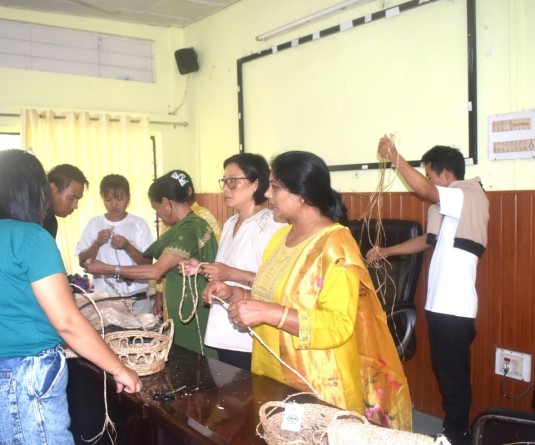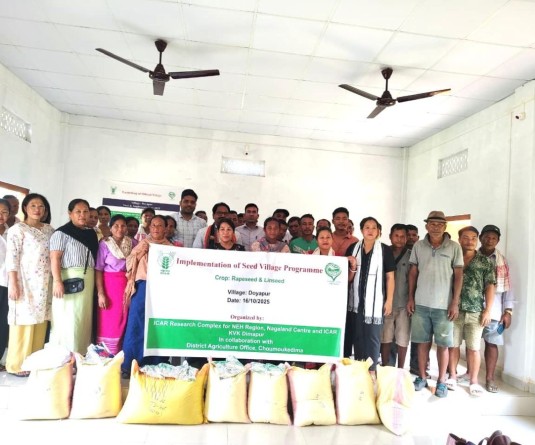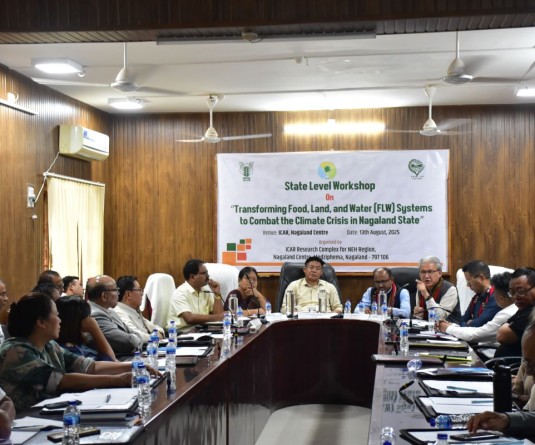
Dr Hannah Krujia
CTO Agronomy, KVK Phek
Seed banks are specialized facilities that store seeds to preserve genetic diversity for future generations. These vaults are designed to withstand extreme conditions such as floods, bombings, and radiation, ensuring long term viability of seeds. Seeds are typically stored in climate controlled environments with low humidity and temperature around -18°C, which minimizes metabolic activity and extends their lifespan. Globally, there are over 1,700 seed banks, varying in size, focus, and type. Some focus on local species, while others aim for broader biodiversity conservation. Community seed banks play a vital role in supporting farmers by providing rare and locally adapted varieties that are resilient to environmental challenges
The Svalbard Global Seed Vault, often referred to as the "doomsday vault," is one of the most prominent seed banks. Located in Norway’s Arctic region, it serves as a backup repository for seed collections worldwide. With a capacity to store 4.5 million crop varieties (equivalent to 2.5 billion seeds), it currently houses over 1.3 million seed samples from nearly every country. The vault is built into permafrost and reinforced with artificial cooling to maintain optimal storage conditions even in the event of power loss
Recent developments highlight its importance in February 2025, the vault received a significant deposit of 14,000 seed samples from 21 genebanks globally, including seeds from regions affected by conflict or natural disasters such as Sudan and the Philippines. This milestone underscores its role in safeguarding global food security amidst climate change and population growth challenges
WHY SEEDS BANKS ARE IMPORTANT?
Growing food starts with seeds. Plants are very important for the planet and for all living things. But plants are in danger because of things like losing their homes, climate change, pollution, pests, and diseases. Seed banks help protect plants and make farming stronger during hard times.
About 40% of plant species in the world are at risk of disappearing forever. This includes rare, old, native, wild, or special local plants. If these plants disappear, we could lose important genes that help our food grow. Without good genetic diversity, adapting to climate change or new pests can be challenging. Crop breeders require a diverse set of genetic resources to help in the adaptation of our crops to changing situations. A seed bank is a type of insurance that allows us to safeguard as many plant species as possible from extinction.
Selection, Collection and Storing of seeds
Experts and volunteers from all over the world meticulously gather seeds for the seed banks. Plant breeders and researchers make a decision of which seeds to collect, often prioritizing endangered plant species. The seeds are collected when ripe, which is crucial for their viability. After collection, seeds are cleaned to remove impurities and dried in a controlled environment to reduce moisture content, which is critical for preventing mold and decay. Once dried, the seeds are sealed in airtight containers and stored at low temperatures, typically around -20°C, to slow down their metabolic rate and extend their viability. This cold storage can preserve most seeds for decades, although the exact shelf life varies depending on the seed type. Some seeds, due to their unique characteristics, may require cryopreservation or in-vitro storage, where living plant tissues are frozen in liquid nitrogen at temperatures around -196°C. This method is especially useful for species that do not produce seeds or have seeds that do not respond well to conventional storage methods. As an additional assurance, it is customary practice for each bank to send a portion of its precious seeds to another bank as an emergency backup. Some banks preserve seeds connected to agricultural crops, while others may only keep seeds from uncommon species with a very restricted sharing policy. Depending on the species, seeds stored in these vaults are sometimes dormant for hundreds or even thousands of years.
BENEFITS OF SEED BANKS
The conserved seeds contain a wealth of beneficial genes that breeders might employ to build improved varieties of our most important food crops. A few specific benefits of seed banks are:
• Improve plant disease and pest resistance, both existing and emerging
• Allow for drought or flood resistance
• To feed a growing global population, increase yields and improve nutrition
Need for Creating Seed Banks
The necessity for seed banks has grown importance due to the escalating challenges of climate change, habitat destruction, and agricultural practices that reduce genetic diversity. Modern agriculture’s reliance on monocultures and high yield varieties has led to a significant reduction in the genetic diversity of crops, making them more susceptible to diseases, pests, and changing climatic conditions. Seed banks preserve a wide array of plant genetics, providing a resource for reintroducing species and enhancing genetic diversity within crops.
CONCLUSION
Around the world, seed banks house large collections of plant species that are essential for scientific research, education, species protection, and the preservation of Indigenous traditions. Seed banks contain a large number of seeds for a variety of objectives, such as restocking populations, research studies, and plant breeding programs. Seed banks that are well funded and well maintained are essential to mitigate the impact of the climate on agriculture. This genetic reservoir ensures that future generations have access to a wide variety of plant traits, which can be vital for ensuring biodiversity, breeding new crop varieties, restoring habitats, and ensuring food security in the face of changing environmental conditions.
Courtesy:
https://fsii.in/seed-bank-and-its-importance
https://croptrust.org/news-events/in-the-media/seed-banks-the-last-line-of-defense-against-a-threatening-global-food-crisis






